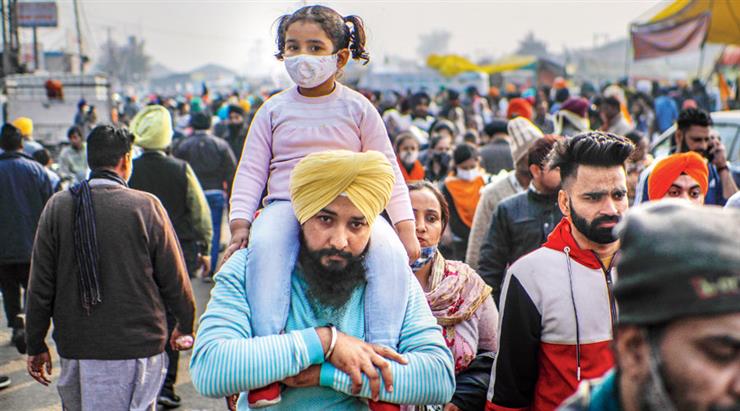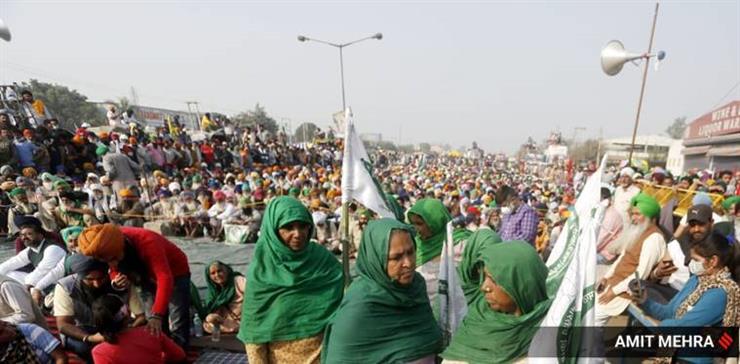The election scenario emerging in Punjab in the forthcoming assembly elections does not appear to be what it is. Most of the political parties are dissecting society in the traditional format of castes and sub-castes, hoping the situation will go in their favour. But it appears that the calculations of almost all will lead them to surprising results.
The 380-days long strong protests by farmers at various Delhi borders have politicised the Punjabis, especially those living in rural Punjab or having roots in villages but live in urban areas of the state. Their politicisation has impacted the next two generations, including young boys and girls and even children. Many of them had joined their parents in the protests, contributing their share by rotation. Young girls looked after the farms in the absence of their parents, visiting their agriculture fields to minimise losses. They even drove tractors on their fields, while males or other members of the family participated in the protests in various places surrounding Delhi to protest the three notorious Farm Laws. Their work back home while their parents continued to struggle for the repeal of the three Farm Laws are expected to mould the opinion of their elders on whom to vote.
Sukhbir Badal’s Akali Dal (SAD) may succeed in improving its tally for having its alliance with the Mayawati-led Bahaujan Samaj Party (BSP). But it appears that the SAD will not be able to show itself as a clean political dissipation that has a commitment to serve the people of Punjab if at all it comes to power. During Parkash Singh Badal’s two consecutive terms rule in Punjab the transport mafia, drug mafia, liquor mafia, sand mafia, and above all the land and urban property grabbers--flourished the most. Small transporters were forced to transfer their permits to a Bhatinda transport company. Drugs were made easily available in villages through dummy medical stores with the help of certain top police officers. Most talk of young boys who were enticed in drug addiction, but no one talks about 80, 000 young females addicts, living miserable life.
Over one year is too long a period to strengthen the protesters' anti-Centre mind, especially against Prime Minister Narendra Modi. Keeping in view this back ground in mind, it will not be wrong to say that the Bhartiya Janata Party (BJP) led alliance of Captain Amarinder Singh in his new avatar as President of the Punjab Lok Congress (PLC) and Sukhdev Singh Dhindsa of the Shiromani Akali Dal-Sanyukt), does not have any noticeable following in Punjab. Dhindsa has never been a mass leader. It appears his party will not get much response during voting. Hockey icon Olympian Ajitpal Singh failed to file his nomination as he is not a voter. Six PLC candidates refused to file papers on the PLC’s Hockey-Ball symbol saying that voters will not recognise it. Even some BJP supporters have reportedly objected to supporting non-BJP candidates. Therefore, these six candidates filed papers as BJP candidates. The BJP leaders and members in Punjab were silent spectators when Punjab’s farmers heading towards Delhi to lodge their protests against the farm bills faced the strong hands of the Haryana police.

a protester carrying his daughter on his shoulders during protest at Delhi border
With the inspiration from Home Minister Amit Shah, Amarinder has arranged a loose and weak alliance to damage the prospects of Congress in Punjab and ensure Navjot Singh Sidhu is defeated. Amarinder opposed Sidhu’s appointment as Congress chief in Punjab putting forward an argument that balance must be maintained and if a Sikh is chief minister, then a non-Sikh should be appointed state Congress president. But did his bureaucratic set-up which was running the state, maintain communal balance there? His Chief Secretary, DGP, Home Secretary, Education Secretary, Chief Principal Secretary, all were non-Sikhs.

In fact, Amarinder is a puppeteer (of Amit Shah) and was brought in to run a dis-jointed alliance of defunct political leaders. He is drawing lines out of vengeance keen to settle his score with Sidhu. In a similar way, Dhindsa (SAD-Sanyukt) nurses a grudge and is too keen to settle scores with Shiromani Akali Dal leader Sukhbir Badal for obstructing his turn to become cabinet minister in Modi’s government and instead of securing a cabinet position for his wife.
During his four and half years of rule, all types of mafias ---- liquor, drug, sand, transport ---- continued to flourish. Amrinder did nothing to stop the loot of Punjab’s wealth. Every unethical MLA and minster became richer under his leadership.
His pre-election promises to provide smartphones to youth remains partly fulfilled, as very few lucky ones got them.
Instead of relying on his ministers, Amarinder relied more on bureaucracy to run his government while remaining in the comforts of his newly constructed seven-star villa in Mullanpur. The Congress would have been better placed had it removed Amarinder a year ago or much earlier. His administration had had its share in allowing all mafias to flourish with impunity. The state’s income was siphoned off by politically supported to the mafias’ coffers. He was removed as chief minister because 60 MLAs wrote to the Congress high command that it was not possible to win the elections under his leadership. Two reasons were cited:
1) He was working under instructions from the BJP high command because of Enforcement Directorate cases against him and members of his family.
2) He was helping SAD (Badal) in escaping from sacrilege cases and Bulgari firing incident in which the DGP and IG Punjab were accused. He was a poor administrator.
The BJP puppet Amarinder still hopes of forming his government with the help of the saffron party. He compromised with corrupt MLAs and minister to stay in the comforts of power. It will be difficult for Amrinder’s three-party alliance to cross the two digits figure. The masses not allowing BJP leaders to enter villages for campaigning. It is the same in Uttar Pradesh. More than 700 farmers sacrificed their lives during their struggle to get the farm laws repealed. Over 450 were from rural Punjab.
Amarinder has made public his relationship with the Pakistan establishment when he said that a friend from Pakistan had conveyed him Prime Minister Imran Khan’s message to reappoint Sidhu as a cabinet minister. If he can have friends with Pakistan nationals, why can’t Sidhu be friends with Imran? They have played many cricket matches against each other but remain friends till now.
Consequent of the farmers’ protests, another development has occurred in Punjab with a group of well-meaning retired bureaucrats joining hands to provide a positive direction to Punjabis in the assembly elections. Such a group has emerged in Punjab for the first time.
Sukhbir Badal’s Akali Dal (SAD) may succeed in improving its tally for having its alliance with the Mayawati-led Bahujan Samaj Party (BSP). But it appears that the SAD will not be able to show itself as a clean political dissipation that has a commitment to serve the people of Punjab if at all it comes to power. During Parkash Singh Badal’s two consecutive terms rule in Punjab the transport mafia, drug mafia, liquor mafia, sand mafia, transport mafia, and above all the land and urban property grabbers--flourished the most. Small transporters were forced to transfer their permits to a Bhatinda transport company. Drugs were made easily available in villages through dummy medical stores with the help of certain top police officers. Most talk of young boys who were enticed in drug addiction, but no one talks about 80, 000 young females addicts, living miserable life.
In the 2017 assembly elections, committed BJP voters voted for Congress candidates to restrict the emergence of the Aam Aadmi Party (AAP). But this time, with the AAP engulfing itself in soft Hindutva, has become more aggressive. As the campaign nears the end, the BJP may shift its votes to AAP to restrict Congress from forming the government in Punjab. The BJP has no high stakes in Punjab, but its high command (Modi-Shah combine) is eyeing the 2024 parliamentary elections. The BJP considers only a challenge from the Indian National Congress to Modi’s leadership.
The Sanyukt Samaj Morcha (SSM), a new dispensation of farmers led by eminent Kisan leader Balbir Singh Rajewal, though unable to secure an election symbol, is likely to also win a few seats. It is supported by a group of retired Punjab bureaucrats, retired army officers and some well-wishers of Punjab from other fields.
Although traditional political parties continue to make claims of forming the government in Punjab, this time the traditional pattern of casting votes on communal and religious lines and caste base has been disarrayed under the impact of a strong kisan-mazdoor joint protest to guard their land against the Modi government’s onslaught.
Under such an atmosphere, where more than 60 percent of the population lives in rural areas and is dependent on agriculture in Punjab, all those aligning with the BJP or pro-BJP leaders will be disheartened on March 10, the day of counting.
We have three CM faces ---- Charanjit Singh Channi (Congress), Bhagwant Mann (AAP), SAD (Badal) Sukhbir Badal. So far, Channi is much ahead of the other two in popularity. The three-party alliance led by Amarinder is the least popular. Little wonder it is scared of announcing Amarinder as its CM face.